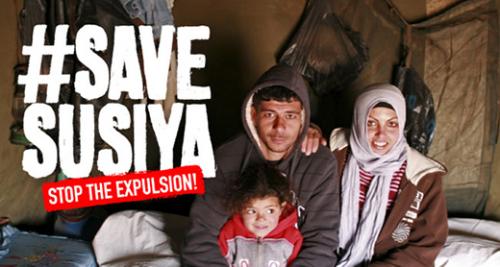
On 22 November, B’Tselem, the Israeli Information Centre for Human Rights in the Occupied Territories, issued a press release detailing the continuing ethnic cleansing of Palestinians in the Occupied Territories.
The release reported that over the previous month the state had informed three Palestinian communities, two in the Jordan Valley and one near Jerusalem that it intended to expel them from their homes and land, giving them eight days to leave. The notification was made by leaving orders on the roadside. The three communities, largely Bedouin, comprise 414 people, including 151 youths and children under 18.
Such expulsions of Palestinians from areas in the West Bank, especially in the fertile Jordan Valley, have continued for many years. In the past, efforts were based mainly on military orders concerning planning and building. However, the proceedings concerning such orders are protracted and require the precise mapping of the land and buildings, as well as the issuing of separate demolition orders for each building.
Now the state has found a new mechanism it hopes will enable it to circumvent such proceedings and accelerate the expulsion of residents: the Order concerning Unauthorized Buildings (Temporary Provision) (Judea and Samaria) (No. 1539), 5744-2003. Ironically this order was originally intended for the expulsion of settlers from 'outposts' established around the West Bank, although the state very rarely used it for this purpose.
The order allows the military commander to declare an area in the West Bank a 'confined area', and to order the eviction of all property in that area. On this basis of this order, GOC central command major-general Roni Numa signed the new orders concerning the Palestinian communities.
It seems that Israel is so confident in its ability to expel entire villages without incurring judicial or international criticism that it is no longer bothering to create even the illusion of legal proceedings. However, the difference between the proceedings is purely technical.
The planning and building proceedings never stopped the state. Even if the procedures managed to postpone expulsion, they never removed the threat of expulsion from thousands of people. Over many years, thousands of Palestinians in dozens of communities have lived under a constant and real threat. The state has refused to regulate their status, allow them to connect to the water and electricity infrastructure, establish educational institutions for their children, pave roads to their living areas, and maintain a reasonable living routine.
The state has recently declared its intention to expel two additional communities over the coming months – Susiya in the southern Hebron Hills, and Khan al-Ahmar close to Ma'ale Adumim. Defense minister Avigdor Lieberman announced that in the absence of opposition from the US administration, these communities will be expelled by April 2018. The expulsion proceedings against these communities have continued for years before the Israeli supreme court, which has refrained from prohibiting their expulsion.
Whatever the processes used by the state in its attempt to expel Palestinian residents from their homes, the crime is the same: the forcible transfer of a protected population, which amounts to a war crime. This is the case whether the violence used is direct or indirect, physical or administrative.
Whether the expulsion is undertaken by force or by creating an intolerable reality that forces the residents to leave their homes and land, the essence is the same. All those involved in committing this crime – including the prime minister, defense minister, the justices who approve the expulsion, and the GOC who signs the orders – bear personal liability.

